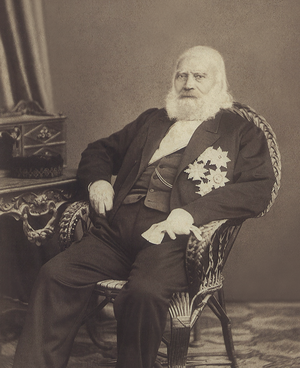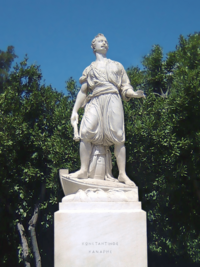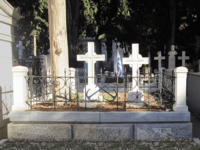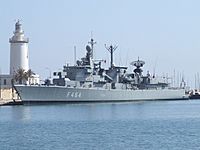Konstantinos Kanaris facts for kids
Quick facts for kids
Konstantinos Kanaris
|
|
|---|---|
| Κωνσταντίνος Κανάρης | |

Konstantinos Kanaris, Prime Minister of Greece.
|
|
Prime Minister of Greece |
|
| In office 12 February 1844 – 30 March 1844 (o.s.) |
|
| Monarch | Otto |
| Preceded by | Andreas Metaxas |
| Succeeded by | Alexandros Mavrokordatos |
| In office 27 October 1848 – 14 December 1849 (o.s) |
|
| Preceded by | Georgios Kountouriotis |
| Succeeded by | Antonios Kriezis |
| In office 5 March 1864 – 16 April 1864 (o.s) |
|
| Monarch | George I |
| Preceded by | Dimitrios Voulgaris |
| Succeeded by | Zinovios Valvis |
| In office 26 July 1864 – 2 March 1865 (o.s) |
|
| Preceded by | Zinovios Valvis |
| Succeeded by | Alexandros Koumoundouros |
| In office 26 May 1877 – 2 September 1877 (o.s) |
|
| Preceded by | Alexandros Koumoundouros |
| Succeeded by | Alexandros Koumoundouros |
| Personal details | |
| Born | c. 1790 Psara, Eyalet of the Archipelago, Ottoman Empire (now Greece) |
| Died | 2 September 1877 (aged 87) Athens, Kingdom of Greece |
| Resting place | First Cemetery of Athens |
| Political party | Russian Party |
| Spouse | Despina Maniati |
| Children | Nikolaos Kanaris Miltiadis Kanaris Themistoklis Kanaris Aristeidis Kanaris Lykourgos Kanaris Maria Kanari Thrasyvoulos Kanaris |
| Awards | |
| Signature | |
| Military service | |
| Allegiance | |
| Branch/service | |
| Years of service | 1821–1844 |
| Rank | Admiral |
| Battles/wars |
|
Konstantinos Kanaris (Greek: Κωνσταντίνος Κανάρης), also known as Constantine Kanaris, was a brave Greek leader. He was an admiral and a politician. He is remembered as a hero of the Greek War of Independence.
Contents
Biography
Growing Up
Konstantinos Kanaris was born on the island of Psara. This island is near Chios in the Aegean Sea. We don't know his exact birth year. Some records say 1795, but many historians think it was 1790 or 1793.
He became an orphan when he was young. To support himself, he became a seaman. This was a common job for his family. He started working on his uncle's ship, a type of sailing vessel called a brig.
Fighting for Freedom
Kanaris became famous during the Greek War of Independence (1821–1829). This was a fight for Greece's freedom from the Ottoman Empire. Unlike many other leaders, he was not part of the secret group called Filiki Eteria. This group helped start the revolution.
In early 1821, the fight for freedom began. Kanaris was in Odessa at the time. He quickly returned to Psara island. He was there when Psara joined the uprising on April 10, 1821.
Psara formed its own fleet of ships. The sailors from Psara were already known for their strong ships. They were also good at fighting sea pirates. They became very skilled in naval warfare, which means fighting at sea. Kanaris soon became known for using "fire ships."

A fire ship was an old ship filled with explosives. It was set on fire and sent towards enemy ships. On a dark night, June 6–7, 1822, Kanaris led an attack near Chios. His forces destroyed the main ship of the Ottoman fleet's admiral, Nasuhzade Ali Pasha. This was revenge for the terrible Chios massacre.
The admiral was having a special celebration. This allowed Kanaris and his men to get their fire ship close without being seen. When the main ship's powder storage caught fire, everyone on board died instantly. About 2,300 Turkish sailors and officers, including the admiral, were killed.
Kanaris led another successful attack in November 1822 at Tenedos. He was known for whispering to himself, "Konstantí, you are going to die," every time he approached a Turkish warship with a fire ship.
The Ottoman fleet captured Psara on June 21, 1824. Many people, including Kanaris, escaped the island. But those who stayed were either captured or killed. After his home island was destroyed, he kept fighting against the Turkish forces. In August 1824, he fought in sea battles in the Dodecanese islands.
The next year, Kanaris led a daring raid on Alexandria. He tried to destroy the Egyptian fleet with fire ships. It might have worked, but the wind stopped just as the Greek ships entered Alexandria harbor.
After the war ended and Greece became independent, Kanaris joined the new Hellenic Navy. He became a high-ranking officer, reaching the rank of admiral. He also became an important politician.
Political Leadership
Konstantinos Kanaris was one of the few people trusted by Ioannis Kapodistrias. Kapodistrias was the first leader of independent Greece. After Kapodistrias was murdered on October 9, 1831, Kanaris moved to the island of Syros.
When King Otto I ruled, Kanaris served as a minister in different governments. He then became Prime Minister for a short time (February 16–March 30, 1844). He served a second term as Prime Minister (October 15, 1848–December 12, 1849). He also served as the Navy Minister in 1854.
In 1862, he was one of the few heroes from the War of Independence who took part in a peaceful uprising. This uprising removed the unpopular King Otto I from power. It led to Prince William of Denmark becoming King George I of Greece. During King George's rule, Kanaris served as Prime Minister three more times:
- March 6–April 16, 1864
- July 26, 1864–February 26, 1865
- June 7–September 2, 1877
Kanaris died on September 2, 1877, while he was still Prime Minister. His government stayed in power for a while after his death. He was buried in the First Cemetery of Athens. His heart was placed in a special silver urn.
Legacy
Konstantinos Kanaris is a national hero in Greece. He is considered one of the most important people in the Greek War of Independence. Many statues and busts (head and shoulders sculptures) have been made to honor him. These include "Kanaris at Chios" in Palermo and a statue in Kypseli, Athens. He was also featured on a Greek coin and a banknote.
To honor Kanaris, several ships of the Hellenic Navy have been named after him:
- Kanaris, a gunboat from 1835
- Kanaris, a torpedo boat tender from 1880
- Kanaris (L53), a destroyer from 1942
- Kanaris (D212), a destroyer from 1972
- Kanaris (F464), a frigate from 2002
A place in New Zealand, Te Korowhakaunu / Kanáris Sound, was also named after him. This was done by a French explorer named Jules de Blosseville.
Family Life
In 1817, Konstantinos Kanaris married Despoina Maniatis. She came from a well-known family from Psara.
They had seven children:
- Nikolaos Kanaris (1818–1848), who died during a military trip.
- Themistoklis Kanaris (1819–1851), who also died during a military trip.
- Thrasyvoulos Kanaris (1820–1898), who became an admiral.
- Miltiadis Kanaris (1822–1901), who was an admiral and a member of the Greek Parliament. He was Naval Minister three times.
- Lykourgos Kanaris (1826–1865), a naval officer and lawyer.
- Maria Kanaris (1828–1847).
- Aristeidis Kanaris (1831–1863), an officer who died in an uprising.
A German Admiral named Wilhelm Canaris once thought he might be related to Konstantinos Kanaris. However, a family history study in 1938 showed that he was from Italy and not related to the Greek Kanaris family.
Honours
Greek Honours
 Order of the Redeemer (Kingdom of Greece): Grand Cross, 1864
Order of the Redeemer (Kingdom of Greece): Grand Cross, 1864
Foreign Honours
 Royal Guelphic Order (Kingdom of Hanover): Grand Cross
Royal Guelphic Order (Kingdom of Hanover): Grand Cross Order of the Dannebrog (Kingdom of Denmark): Grand Cross
Order of the Dannebrog (Kingdom of Denmark): Grand Cross
See also
 In Spanish: Konstantinos Kanaris para niños
In Spanish: Konstantinos Kanaris para niños
- List of prime ministers of Greece
- Greek War of Independence
- Kanaris family
- Hellenic Navy
- History of Greece
- Greek ship Kanaris
- First Cemetery of Athens







